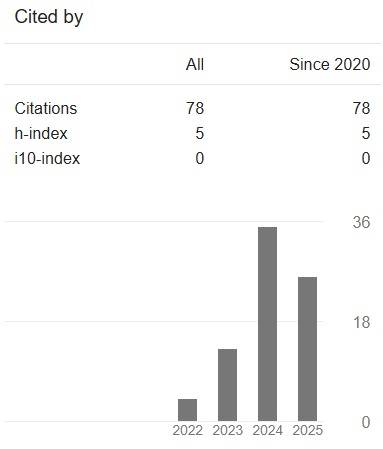Modelling and Simulation of Cyclic Nanoindentation for Y-TZP Ceramic
DOI:
https://doi.org/10.24191/jaeds.v4i2.79Keywords:
FEM, Cyclic nanoindentation, abaqus, Y-TZP ceramicAbstract
Cyclic nanoindentation is a robust experimental method that enables an in-depth analysis of how materials behave mechanically under repeated loading conditions. The aim of this study is to utilize the cyclic nanoindentation technique in order to assess the mechanical characteristics, including elastic and plastic deformations, of yttria-stabilized tetragonal zirconia polycrystals (Y-TZP) ceramic material through simulation. A two dimensional Finite Element Analysis (FEA) model is employed to create a nanoindentation simulation with a Berkovich indenter. The cyclic nanoindentation simulation model provides the outcome of the sample's deformation response and the load-displacement curve for each loading cycle of peak load of 500 mN. This model builds upon our previous research with Saedon et al., where we successfully replicated the load-displacement curve obtained by earlier researchers through a single nanoindentation simulation. Given that the sample model is reliable, the results achieved with Y-TZP ceramic are also depandable. In conclusion, this research has successfully replicated the cyclic nanoindentation method using a Berkovich indenter simulation to analyse and understand the mechanical characteristics of Y-TZP ceramic, which is commonly employed in dental prosthetics.
Downloads
References
A. Moradkhani, H. Baharvandi, and A. Naserifar, “Fracture toughness of 3Y-TZP dental ceramics by using Vickers indentation fracture and SelNB methods,” Journal of the Korean Ceramic Society, vol. 56, no. 1, pp. 37–48, 2019, doi: 10.4191/kcers.2019.56.1.01.
H. M. Rao, M. Kumaraswamy, D. Thomas, S. Boraiah, and K. S. Rana, “Zirconia in Restorative Dentistry,” in Zirconia, U. M. B. Al-Naib, Ed., Rijeka: IntechOpen, 2023, ch. 5. doi: 10.5772/intechopen.111601.
I. Denry and J. A. Holloway, “Ceramics for dental applications: A review,” Materials, vol. 3, no. 1, pp. 351–368, 2010, doi: 10.3390/ma3010351.
E. Kontonasaki, A. E. Rigos, C. Ilia, and T. Istantsos, “Monolithic Zirconia: An Update to Current Knowledge. Optical Properties, Wear, and Clinical Performance,” Dent J (Basel), vol. 7, no. 3, 2019, doi: 10.3390/dj7030090.
W. M. Ahmed, T. Troczynski, A. P. McCullagh, C. C. L. Wyatt, and R. M. Carvalho, “The influence of altering sintering protocols on the optical and mechanical properties of zirconia: A review,” Journal of Esthetic and Restorative Dentistry, vol. 31, no. 5, pp. 423–430, 2019, doi: https://doi.org/10.1111/jerd.12492.
O. S. Abd El-Ghany and A. H. Sherief, “Zirconia based ceramics, some clinical and biological aspects: Review,” Future Dental Journal, vol. 2, no. 2, pp. 55–64, 2016, doi: https://doi.org/10.1016/j.fdj.2016.10.002.
Y. Zhang and B. R. Lawn, “Novel Zirconia Materials in Dentistry,” J Dent Res, vol. 97, no. 2, pp. 140–147, 2018, doi: 10.1177/0022034517737483.
A. Y. Alqutaibi et al., “Revolution of Current Dental Zirconia: A Comprehensive Review,” Molecules, vol. 27, no. 5, 2022, doi: 10.3390/molecules27051699.
H. Pelletier, J. Krier, A. Cornet, and P. Mille, “Limits of using bilinear stress-strain curve for finite element modeling of nanoindentation response on bulk materials,” Thin Solid Films, vol. 379, no. 1–2, pp. 147–155, 2000, doi: 10.1016/S0040-6090(00)01559-5.
J. Saedon et al., “Development of Nanoindentation Simulation Technique for Y-TZP Ceramic Material Characterization,” 2022, pp. 207–216. doi: 10.1007/978-981-19-2890-1_21.
L. Shao, D. Jiang, and J. Gong, “Nanoindentation characterization of the hardness of zirconia dental ceramics,” Adv Eng Mater, vol. 15, no. 8, pp. 704–707, 2013, doi: 10.1002/adem.201200367.
A. K. Bhattacharya and W. D. Nix, “Finite element simulation of indentation experiments,” Int J Solids Struct, vol. 24, no. 9, pp. 881–891, 1988, doi: 10.1016/0020-7683(88)90039-X.
N. Chollacoop, M. Dao, and S. Suresh, “Depth-sensing instrumented indentation with dual sharp indenters,” Acta Mater, vol. 51, no. 13, 2003, doi: 10.1016/S1359-6454(03)00186-1.
G. M. Pharr and W. C. Oliver, “On the generality of the relationship among contact stiffness, contact area and elastic modulus during indentation,” J Mater Res, vol. 7, no. 03, 1992.
M. Sakai, “Meyer hardness: A measure for plasticity?,” J Mater Res, vol. 14, no. 9, pp. 3630–3639, 1999, doi: 10.1557/JMR.1999.0490.
A. R. Alao and L. Yin, “Assessment of Elasticity, Plasticity and Resistance to Machining-induced Damage of Porous Pre-sintered Zirconia Using Nanoindentation Techniques,” 2016. doi: 10.1016/j.jmst.2016.02.009.
L. Wu, Z. Sun, J. Zhao, and Y. Zheng, “Retrospective clinical study of monolithic zirconia crowns fabricated with a straightforward completely digital workflow,” Journal of Prosthetic Dentistry, vol. 128, no. 5, pp. 913–918, Nov. 2022, doi: 10.1016/j.prosdent.2021.01.018.
Downloads
Published
How to Cite
Issue
Section
License
Copyright (c) 2024 Juri Saedon, Siti Khaiyisah Haidah Baharudin

This work is licensed under a Creative Commons Attribution 4.0 International License.









